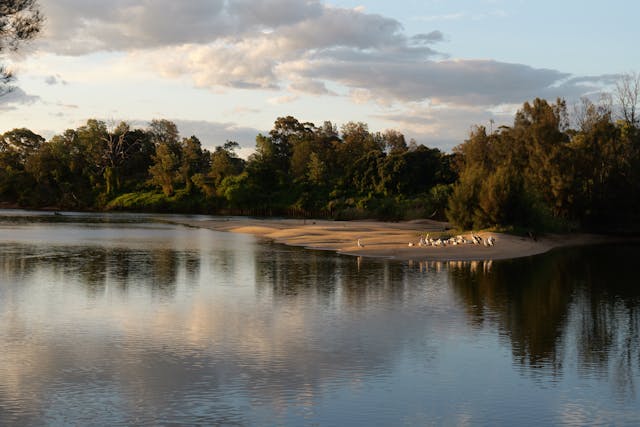
Written by Lucia Snyderman, PhD researcher in Environmental Science at the University of Reading & Zoological Society of London
“In Nature nothing exists alone” – Rachel Carson, Silent Spring
A tale of extinction
There was once a wetland in England where white wings danced upon the surface and silvery bodies scavenged below. There was once a wetland where people coexisted with pelican and sturgeon, the white and silver ghosts of the fen. Though these people fought for their homeland against the expanding empire, after centuries their homeland was drained. The watery ghosts left. The sturgeon swam out to sea where they were heavily overfished and never returned to spawn, small ribbons held in sphagnum memory. When the pelican took flight, she became a shrinking reflection, a sea-foam shadow, a one-way migration. The peat, exposed by low water level and marked by wooden posts instead of animal tracks, began to oxidize and release carbon dioxide. A sigh, a surrender, a secret long held released into the changing atmosphere. There were still people who remembered the pelican and sturgeon, wondered where they had gone, if their children would ever see that magnificent beak that held so much or cup a sturgeon fry in palm.
This is one story of an ecosystem lost. Of a relationship between people and nature lost. Through my PhD at the University of Reading and Zoological Society of London, I am working to disentangle the drivers of species and ecosystem loss in Europe over the past several millennia to better inform and restore ecosystems so that humans and other species can coexist once again in harmony and be resilient in the face of climate change. Evidence supports that restoring wild animals and the functional roles they play in their ecosystems can enhance carbon capture and storage [1].
Across the planet, human-wildlife coexistence (where both humans and wildlife thrive) is in peril with climate change as an ever-pressing threat. There is a growing loss of connection to nature and unsustainable harvest practices continue without just regulation. According to the IUCN Red List – the global authority on the conservation statuses of species – more than 46,300 species are threatened with extinction [2]. This is unprecedented as current rates of extinction are 1000 times the background rate of extinction [3]. We know these declines are primarily due to human-driven activities. We do not even need to look at the data to see it; we are all witnesses to extinction. Where the passenger pigeon and mountain lion were lost in my home state of Pennsylvania due to overhunting and habitat loss, I now find beauty instead in the bald eagle and the beaver (both saved from extinction due to conservation action). I listen for the hoot of the Great Horned Owl, which may disappear from the Spring soundscape if temperatures and carbon emissions continue to rise.
Climate change is primarily being driven by humans, supported by evidence-based data from fossil and historical archives that contextualise contemporary trends within a longer temporal perspective [4]. Developed nations are especially driving this trend, with the United States coming in second as the greatest carbon emitter [5]. At the 29th United Nations Climate Change Conference (COP29), developed and developing nations as well as Indigenous leaders, scientists, and youth have come together this week to decide what is next for our planet and for people. Although the focus of this meeting is on climate finance, it is essential to consider the relevance of biodiversity and nature conservation for climate change mitigation and minimizing damage and cost incurred from climate change impacts. Without constant prioritisation of the conservation of ecosystems of which humans are an integral part, climate action and climate justice will not be successful. I will demonstrate the interconnectedness of biodiversity, climate, and people through marine ecosystem examples as the ocean has historically been neglected despite its potential for climate solutions and importance to many different groups of people who are being (and will continue to be) impacted by climate change. Marine ecosystems are rightfully coming to the forefront at COP29 in climate policy and action dialogue.
Sea-change (ocean potential for climate, people, and wildlife solutions)
“Oceans are victims of climate change but also bearers of solutions for climate change impacts.” – Mirey Atallah at “Exploring the climate biodiversity and ocean nexus” discussion in the UNFCCC Pavilion, COP29
- The ocean itself is a huge carbon store, including lesser-known sea creatures behind the scenes.
Dr. Narissa Bax, Marine Scientist at Grønlands Naturinstitut assessing blue carbon potential, shared her knowledge with me on the importance of the deep sea and its potential for nature and ocean-based solutions in mitigating climate change impacts.
“There is a need to have adequate climate smart marine-protected areas even in our most isolated regions because this is keeping us alive.”
For instance, in Antarctic marine ecosystems, benthic species such as corals and bryozoans take carbon into their skeletons which is buried into sediment, resulting in carbon sequestration. This carbon that is sequestered into the seafloor by biological systems is known as “blue carbon”. The carbon is taken out of the carbon cycle for years to centuries and, as Dr. Bax said, “is keeping us alive.” Deep-sea mining for rare minerals is one danger to our humble hidden saviors. Mining involves the extraction of minerals from the ocean floor, posing a significant threat to marine species like corals and bryozoans that play a critical role in carbon sequestration.
Dr. Lisa Levin, Distinguished Professor of biological oceanography and marine ecology at the Scripps Institution of Oceanography calls for careful consideration of the consequences of deep-sea mining: “People talk about sustainable mining. I think it’s an oxymoron in the deep sea” [6]. Biodiversity pathways deserve more attention, exploration, and conservation for their role in supporting us and our oceans.
- Healthy oceans support fisheries and people.
By conserving marine biodiversity in the face of climate change, fisheries are protected which in turn supports people whose livelihoods depend on fisheries – a positive feedback loop! According to Dr. Alex Rogers, Deputy Director for Strategic Science Programmes and Partnerships at The National Oceanography Centre, Southampton, fisheries employ 58 million people globally (28% of which are women). In addition to employment, fisheries are crucial for micronutrient and protein intake and thus for human health.
Climate change is currently threatening this essential link between fishery health and human wellbeing; for example, scientific modeling has predicted that tuna may likely migrate out of Exclusive Economic Zones of Pacific Islands by 2050 [7]. Therefore, climate policy and climate finance need to consider this as a looming climate justice issue that will need to be addressed in the coming decades if carbon emissions are not cut drastically and soon.
- As the ocean is so unexplored, there is a lot of biotechnology potential to be discovered.
At deep sea hydrothermal vents, you might expect to find bizarre-looking creatures and think they are irrelevant to the climate challenges we are experiencing far above the deep sea on land, but these odd animals can also contain exciting solutions for us! For instance, the scaly-foot gastropod (Chrysomallon squamiferum) has Myoglobin in its shell which is a protein that has been used to develop a new and efficient eco-friendly material for solar panels [8]. Just because a region is unexplored or out of sight, it does not mean it is irrelevant or lacking potential to solve the challenges humans are facing. While biotechnology presents exciting opportunities, however, it also raises ethical and ecological questions that must be carefully assessed to avoid unintended consequences. For instance, marine carbon dioxide removal, where carbon dioxide is removed from the atmosphere and stored in the oceans through methods such as adding alkaline/liming materials to the ocean, has been proposed as a potential solution to help limit global warming to 1.5 – 2 °C. However, data is still lacking regarding the procedure and potential risks of this approach [9].
Looking forward to COP30 and future meetings, I am excited to continue to explore nature and ocean-based potential and promise at the climate-biodiversity-ocean nexus for our planet’s blue future. In addition to interdisciplinary collaborations, global collaborations will continue to be necessary to address challenges that expand beyond national borders and into uncharted waters. At COP30, nature and climate need to be addressed together, and the connection between the two needs to be stressed and communicated clearly by scientists to policymakers and the public. Nature and climate will not wait for us to deliberate.
- Schmitz, O. J., Sylvén, M., Atwood, T. B., Bakker, E. S., Berzaghi, F., Brodie, J. F., Cromsigt, J. P. G. M., Davies, A. B., Leroux, S. J., Schepers, F. J., Smith, F. A., Stark, S., Svenning, J.-C., Tilker, A., & Ylänne, H. (2023). Trophic rewilding can expand natural climate solutions. Nature Climate Change, 13(4), 324–333. https://doi.org/10.1038/s41558-023-01631-6
- The IUCN Red List of Threatened Species. IUCN Red List of Threatened Species. Retrieved 22 November 2024, from https://www.iucnredlist.org/en
- Pimm, S. L., Jenkins, C. N., Abell, R., Brooks, T. M., Gittleman, J. L., Joppa, L. N., Raven, P. H., Roberts, C. M., & Sexton, J. O. (2014). The biodiversity of species and their rates of extinction, distribution, and protection. Science, 344(6187), 1246752. https://doi.org/10.1126/science.1246752
- Abram, N. J., McGregor, H. V., Tierney, J. E., Evans, M. N., McKay, N. P., & Kaufman, D. S. (2016). Early onset of industrial-era warming across the oceans and continents. Nature, 536(7617), 411–418. https://doi.org/10.1038/nature19082
- Liu, Z., Deng, Z., Davis, S. J., & Ciais, P. (2024). Global carbon emissions in 2023. Nature Reviews Earth & Environment, 5(4), 253–254. https://doi.org/10.1038/s43017-024-00532-2
- Schiffman, R. (2023). Can We Mine the World’s Deep Ocean Without Destroying It? https://e360.yale.edu/features/lisa-levin-interview-deep-sea-mining
- Bell, J. D., Senina, I., Adams, T., Aumont, O., Calmettes, B., Clark, S., Dessert, M., Gehlen, M., Gorgues, T., Hampton, J., Hanich, Q., Harden-Davies, H., Hare, S. R., Holmes, G., Lehodey, P., Lengaigne, M., Mansfield, W., Menkes, C., Nicol, S., … Williams, P. (2021). Pathways to sustaining tuna-dependent Pacific Island economies during climate change. Nature Sustainability, 4(10), 900–910. https://doi.org/10.1038/s41893-021-00745-z
- Yamashita, T., Matsuda, H., Koizumi, K., Thirumalaisamy, L., Kim, M., Negishi, L., Kurumizaka, H., Tominaga, Y., Takagi, Y., Takai, K., Okumura, T., Katayama, H., Horitani, M., Ahsan, N., Okada, Y., Nagata, K., Suzuki, Y., & Suzuki, M. (2023). Heme protein identified from scaly-foot gastropod can synthesize pyrite (FeS2) nanoparticles. Acta Biomaterialia, 162, 110–119. https://doi.org/10.1016/j.actbio.2023.03.005
- Field, C. B., & Mach, K. J. (2017). Rightsizing carbon dioxide removal. Science, 356(6339), 706–707. https://doi.org/10.1126/science.aam9726

